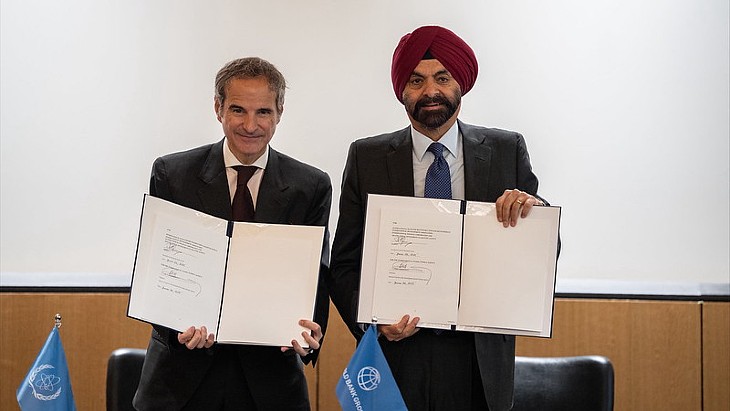Future-forward for front end companies
Front-end fuel cycle companies are ready, willing and able to provide the services needed to ensure a secure supply of nuclear fuel for a growing nuclear generation sector, and are looking to a future with innovative safety-assured fuel designs.
Representatives of leading fuel cycle companies participating in a panel session of top executives at the World Nuclear Association's 2014 Symposium in London were largely unconcerned about wide variations in long-term projections of demand for nuclear fuel - and therefore for capital investment in uranium, conversion, enrichment and fuel fabrication services.
Cameco's Tim Gitzel noted that from a uranium miner's perspective, it can take a long time to bring new primary production online, and other panellists agreed on the importance of global nuclear energy generation plans to their own future planning.
Panellists pointed to ambitious growth plans in China, India, and emerging nuclear energy countries such as the United Arab Emirates, with Converdyn's Malcolm Critchley describing the Emirates Nuclear Energy Agency's Barakah as a "gold standard" project, surely being watched very closely by other countries in the region and likely to follow suit when the project is brought to a successful fruition.
With the centre of gravity for nuclear expansion moving firmly to Asia and the Middle East, the issue of new sovereign fuel cycle facilities in those countries to support their own nuclear power programs was not seen as a threat, with panellists generally of the opinion that while sufficient capacity already exists, there would not be a problem for countries to build their own facilities - where to do so would make economic sense.
Areva's Philippe Hatron pointed out that for a country such as China, with plans for multiple nuclear power plants, investment in domestic fuel cycle facilities would probably be worthwhile. A country with only one or two nuclear units, however, would not generate enough business to support its own front-end facilities. One alternative offered by Lyudmila Zalimskaya of Tenex was the possibility of emerging nuclear countries choosing to invest in existing non-domestic plants.
Secondary issues
Secondary supplies of uranium might not be expected to have many supporters amongst those companies centred on the production and processing of uranium - not least because of their potential disruptive effects on the market for uranium and front-end services. All of the panellists praised the US-Russia HEU program as a good example of the sector, not solely for its noble 'swords into ploughshares' function of transforming former weapons-grade material into energy, but also for the manner in which the introduction of that material into the market had been managed.
Kazatomprom's Nurlan Kapparov felt that secondary supplies, in the long term, would have little significance, while Hatron cautioned against the potentially harmful effects of the release of government uranium inventories onto the market for investment in front-end facilities.
Game-changers
Asked to identify the most significant developments likely to impact the front end in the longer term, several panellists pointed to the possibility of laser enrichment, which Critchley described as a potential "game changer" should it come to commercialisation.
The panellists broadly agreed that development of novel fuel designs and technology would be influential. Fuel using innovative silicon carbide fuel cladding in which hydrogen build up would not be an issue, for example, could offer the possibility of "accident tolerant" nuclear fuel, as described by Yoichi Maeda of Mitsubishi. Urenco's Helmut Engelbrecht called for the promotion of Generation IV reactor technology as a means of extending nuclear growth on the world stage.
Zalimskaya identified increasing vertical integration amongst front-end companies as the most significant potential development. Going even further, she suggested that integration in both the front and back end of the fuel cycle would enable companies to offer a whole package of services to their clients. Vertical integration was also identified by Kapparov as a possible future path for Kazatomprom.
Asked directly to identify what a fuel cycle company must be doing today to ensure success post-2025, the message was clear: fuel cycle companies must employ best practice to serve the customer's needs, guaranteeing security of supply in a safe environment.
Researched and written
by World Nuclear News
_49098.jpg)
_57190.jpg)
_70526.jpg)
_75453.jpg)





..._58412.jpg)

